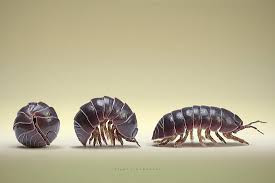 |
| No, not this guy - insect zombies! |
The one thing that all these aggressive zombie-makers have
in common is that they parasitize in the interest of reproduction. They are all
trying to either feed their offspring or find a home to raise them in. They
find a host and use one method or another to gain control of the body and/or mind of
the insect. They then either keep it alive to feed on, cause it to commit
suicide or force it to fulfill some other nefarious purpose of the parasite. How they gain the mind control is, in many instances, still not
thoroughly understood. However, most researchers believe that the parasites
produce neurotransmitters that somehow short out the neurotransmitters of the
host. As gruesome as it seems, parasitization is extremely beneficial to the
parasite (which is why there are so many of them) – it provides for their next
generation and removes a resource competitor at the same time.
Now for the ghoulish details of the work of a few noteworthy
zombie makers:
Emerald cockroach wasp (Ampulex compressa):This lovely solitary wasp will sneak up on a cockroach and sting it in the head a couple of times. This leaves the roach alive but unable to move. After snacking a little on the roach’s antenna, it will lead the mindless roach to a burrow. Now that she has filled the cupboards with groceries, she lays a single egg case on the roach's body and seals the doomed insect up in the burrow. In due time, the wasp larvae will hatch and chew its way into the roach’s abdomen. As the wasp young continue to grow inside the roach, they feast on the living roach’s internal organs. Even while being eaten alive from the inside, the roach never struggles or moves. There is an incredible video on YouTube that shows the wasp creating its personal zombie. See it here.
 |
| The face of a zombie maker (Ampulex compresa) |
Emerald cockroach wasp (Ampulex compressa):This lovely solitary wasp will sneak up on a cockroach and sting it in the head a couple of times. This leaves the roach alive but unable to move. After snacking a little on the roach’s antenna, it will lead the mindless roach to a burrow. Now that she has filled the cupboards with groceries, she lays a single egg case on the roach's body and seals the doomed insect up in the burrow. In due time, the wasp larvae will hatch and chew its way into the roach’s abdomen. As the wasp young continue to grow inside the roach, they feast on the living roach’s internal organs. Even while being eaten alive from the inside, the roach never struggles or moves. There is an incredible video on YouTube that shows the wasp creating its personal zombie. See it here.
Acanthocephala worms and pill bugs (aka Roly Polys): These parasitic worms enter the bodies of pill bugs and then use them as lures for birds. With the ultimate goal or reaching a bird's gut to reproduce in, Acanthocephala worms send pill bugs out to where they can be seen
and eaten by birds. These normally light-hating insects not only go straight
for the sun, they head to lighter colored surfaces to more easily be seen.
That’s refined zombie-making!
 |
| A tarantula hawk subduing a tarantula |
An encounter between a tarantula hawk and a tarantula results is a ghastly and macabre end for the tarantula. On the other hand, an encounter between a human and a tarantula hawk is generally benign. However, should you be unfortunate enough to be stung by one, be prepared to experience an agonizing pain. The pain level that has been given second place (after the South American bullet ant) by Justin Schmidt on his Schmidt sting pain index (see below). Luckily, the pain will dissipate in about five minutes and you can go about your life with a better understanding of what the poor tarantulas suffer. I, personally, will take your word for it.
I have more fascinating and totally disgusting zombies to share with you. Check out Part Two now!
Submitted by Pam







No comments:
Post a Comment